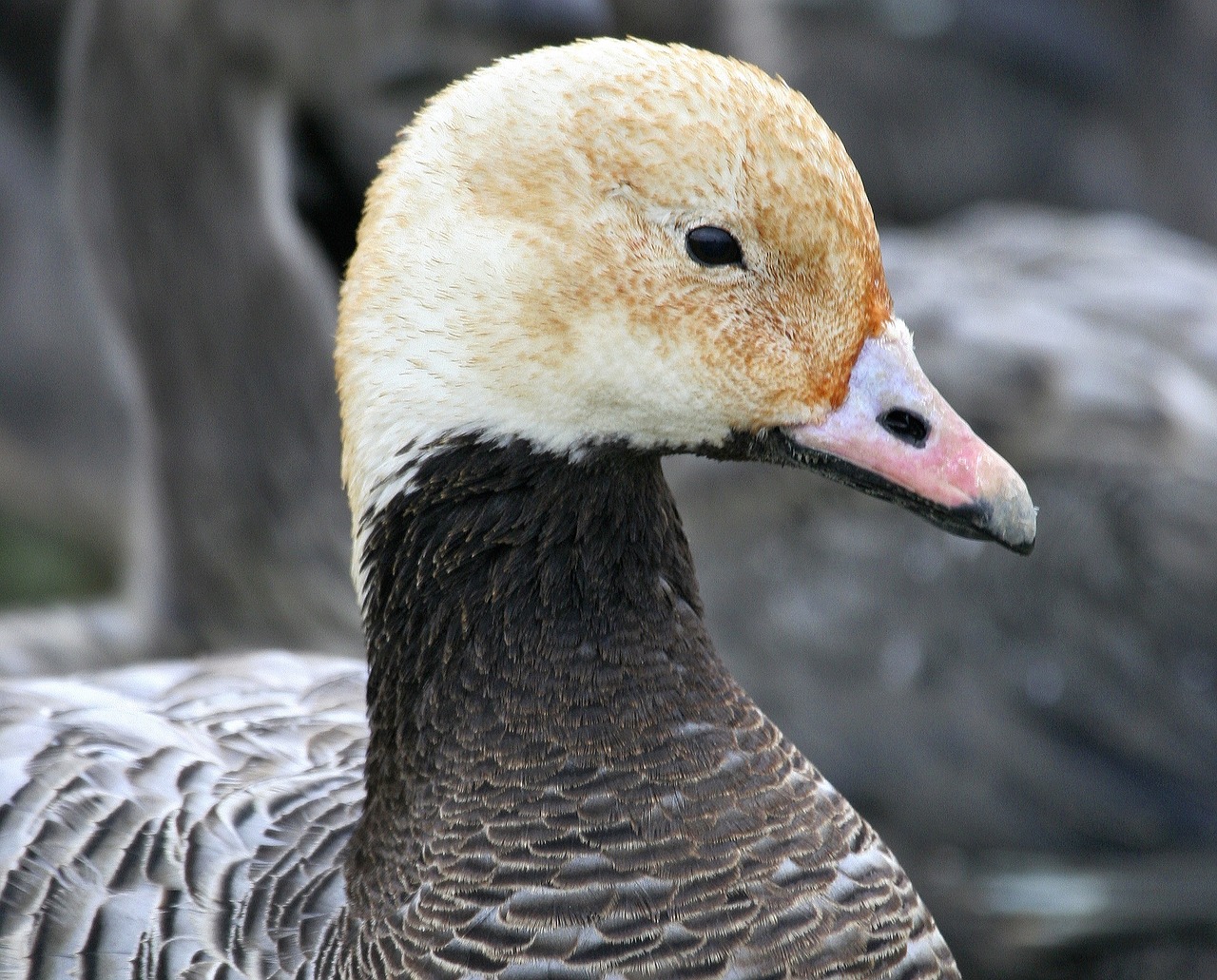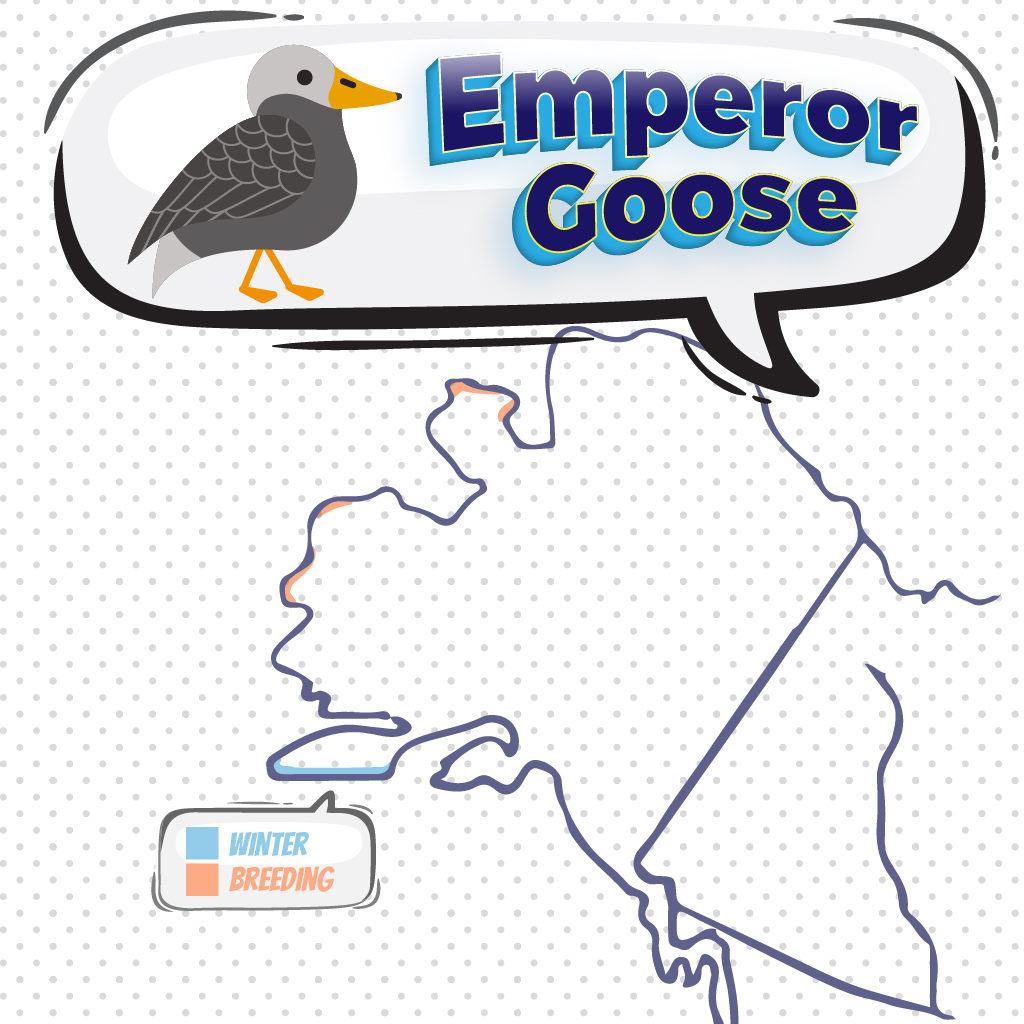
Emperor Goose
An Emperor Goose is a fun bird to see while bird watching. Below are some tips to help you identify Emperor Gooses. We have also put together a list of fun Emperor Goose t-shirts, Emperor Goose bird patches, birdhouses, bird feeders, binoculars, stickers, and other fun bird-watching items.
About the Emperor Goose
These small geese are uncommon and migrate for only a short distance along the Alaskan and Siberia coastal line. Sometimes, they can be found along the coast of Canada and the United States. They rarely mix with other geese and migrate in small groups, although they can be found in large numbers where they meet. Some of their distinctive features include:
Description and Identification
Male and female adult Emperor Geese are similar in appearance with their plumage
being blueish gray in color with spots of black and white. They are characterized by their
pink bill which is colored white at the tip with a white tail, black chin, and neck along with
orange-yellow legs and feet. They sport white coloration at the back of their heads with
an amber-yellow tinge. Several adults’ heads frequently turn rufous in color due to their
feeding in tidal ponds rich in iron oxide. Females are slightly smaller in size and weigh
less than males, though the difference might not be easily visible due to the
minuscule difference. Males generally grow to be 26-28 inches in length and weigh an
average of 6.10 pounds whereas females grow to be between 25.6-27.5 inches in
length and weigh an average of 4.29 pounds.
Emperor Geese Color Pattern
They are primarily gray with blue-gray underparts and upperparts scalloped with black and white. Their bill is pinkish and has a white head. Their tail is white with black underparts which are visible in flight. The legs are yellow-orange.
Emperor Geese Size
They are medium-sized geese with a small bill.
The relative size of both sexes
- Length: 26.0-27.9 in (66-71 cm)
- Weight: 99.2 oz (2813 g)
- Wingspan: 48-56 in (122-142 cm)

Emperor Geese Behavior
They forage mostly on the ground in the forage sites. They reach for roots and graze on fresh growth. Emperor geese can mate for a lifetime and often pair before reaching their breeding site.
What Emperor Geese Eat
The diets of Emperor Geese are primarily plant-based, feeding on algae, roots, etc.
Their diet also varies from season to season. During the winters, they feed largely on
marine algae along with other available plants. In the summers and during the nesting
season, their diet consists of roots, plants, bulbs and berries, and small fruits found near their habitat. Their foraging is majorly concentrated on land, looking for roots and fresh
growing plants and berries. During the winters, given their habitat along rocky coastlines
and mudflats; they forage for food in shallow muddy waters and coasts feeding on
water-based algae and plants.
Emperor geese diet varies with seasons. When on breeding grounds, they feed on roots, bulbs, and other plant materials; this happens in early summer. In late summer, they feed on blueberry or crowberry. They feed heavily on clams and mussels when migrating and during winter. They can also feed on algae and other aquatic plants.
Where the Emperor Goose Lives
In the summer Emperor Geese inhabit the tundra habitats to keep cool, making
themselves at home in freshwater pools, coastal lagoons, and lakes lying inland. In the
winter and fall months, they inhabit mudflats and rocky shores along with water bodies.
In summer, you are likely to find them in tundra while in winter they frequent mudflats and rocky shores. Emperor Geese are closely related to saltwater bodies. During autumn, they can be spotted in California and Oregon. Nest site is mostly on islands in ponds, shoreline, and hummock.
Range and Migration

Emperor Geese, also known by the names beach geese or painted geese are
inhabitants of Alaska and parts of south-east Russia during the summers. They are
known to be located around the Bering Sea, between the continents of Eurasia and
North America. During the winters Emperor Geese can be seen inhabiting the Aleutian
Islands and the southern coast of Alaska along with Kodiak and Afognak Islands. Small
flocks are known to stray away deeper into the United States with small populations
been observed in Washington, Oregon, and in certain rare cases, northern California. In
2016 Emperor Geese were listed under the near-threatened category IUCN Red List but
hunting of this species of geese is permitted in Alaska as the population has seen a
slow increase since 2017. Emperor Geese do not generally mix with other geese, but
they might flock together during migration seasons.
Emperor Goose Lifecycle
The females lay 2-8 eggs and incubate them for 24-27 days. They are fond of laying eggs in other birds’ nests. The young goslings can swim and walk a few hours after hatching. After a day, they leave the nest and follow the parents to the foraging site. They fledge after 50-60 days. Their lifespan is 6 years in the wild.
Emperor Goose Nesting
Nesting season begins towards the end of May and the beginning of June for Emperor
Geese residing in Alaska, for the Emperor Geese that reside in the Russian region,
nesting season may begin a few weeks later in the last week of June. They start mating
after three years of age and are known to remain monogamous. They nest near
shorelines on the open ground. Their nest’s shallow nests are lined with dead plant
material. Once the eggs are laid the female incubates them for a period of 24-27 days.
Once hatched goslings can swim within hours and tend to leave their nests within a day.
Ornithology
Bird Watching Academy & Camp Subscription Boxes
At Bird Watching Academy & Camp we help kids, youth, and adults get excited and involved in bird watching. We have several monthly subscription boxes that you can subscribe to. Our monthly subscription boxes help kids, youth, and adults learn about birds, bird watching, and bird conservation.
Bird Watching Binoculars for Identifying Emperor Geese
The most common types of bird-watching binoculars for viewing Emperor Geese are 8×21 binoculars and 10×42 binoculars. Bird Watching Academy & Camp sells really nice 8×21 binoculars and 10×42 binoculars. You can view and purchase them here.
Emperor Goose T-shirts
If you love the Emperor Goose you should purchase a Bird Watching Academy & Camp T-shirt. To help support bird conservation we donate 10 percent to bird conservation activities.
Emperor Goose Iron On Patches
Kids, Youth, and Adults love to collect our Bird Watching Academy & Camp iron-on patches. Our bird-watching patches help you keep track of the birds you have seen and identified. You can also display the patches on our Bird Watching Academy & Camp banners.
The Emperor Goose is a great iron-on patch to start your collection with. The patches are durable and can be sewn on or ironed on to just about anything.
Emperor Goose Stickers
Stickers are a great way for you to display your love for bird watching and the Emperor Goose. We sell a monthly subscription sticker pack. The sticker packs have 12 bird stickers. These sticker packs will help your kids learn new birds every month.
Bird Feeders For Emperor Geese
There are many types of bird feeders. Here are our favorite bird feeders for your backyard. We use all of these bird feeders currently. Kids will have a great time watching birds eat at these bird feeders. Using this collection of bird feeders will provide a wide variety and many types of birds.
Best Bird Houses for an Emperor Goose
There are many types of birdhouses. Building a birdhouse is always fun but can be frustrating. These 4 birdhouses have become our favorites. Getting a birdhouse for kids to watch birds grow is always fun. We spent a little extra money on these birdhouses but they have been worth the higher price and look great.











